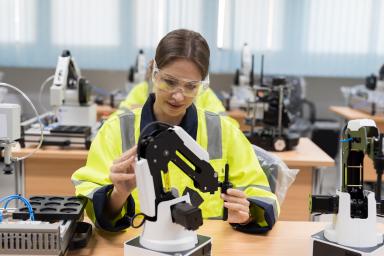10 ways to reduce your office carbon footprint
Start-ups and small businesses can play an active role in helping prevent climate change by reducing the amount of carbon emissions they produce.
Your start-up doesn't need to be a manufacturer, transport business or fashion and textile sector, either.
Office-based start-ups can make changes that can see emissions fall - and it could be seen as a positive move by staff and customers.
A 2021 survey conducted by Censuswide found that 65% of respondents would prefer to work for an environmentally minded company.
Reducing your office's greenhouse gas emissions could also boost your public profile, with research by Deloitte finding that 34% of consumers choose brands with strong, sustainable credentials.
In the UK, smaller businesses are estimated to account for half of all commercial-driven emissions (.PDF, 209.85 KB)(Opens in new window), making the shift towards greener workplaces a key activity in helping keep UK carbon emissions on track to being net zero by 2050.
By taking steps to reduce your start-up's carbon footprint, you could positively contribute to reducing the impact of climate change.
You could also save your start-up money by lowering your energy costs.
Offices can use energy through equipment and utilities, while wasteful workplace habits may add to the office's carbon footprint.
1. Measure your office carbon footprint
Before you can reduce your office emissions, you need to know your current output.
Measuring your carbon footprint is the first step towards creating a greener workplace.
You can use this information to set targets and identify key areas for improvement.
To measure your office carbon footprint, you will need to review all utility bills, travel tickets and fuel receipts from a designated period, usually a calendar year.
You will need to convert your measurements into compatible units - DEFRA offers a useful guide (.PDF, 257 KB)(Opens in new window) - before entering these figures into a calculator, such as the Carbon Trust's SME carbon calculator.
2. Improve your office lighting
According to the Carbon Trust, 20% of all electricity used in the UK is linked to lighting, with many lights still using older, inefficient bulbs.
Energy-efficient lighting sources such as LED bulbs can give a 70% energy saving compared to older fluorescent technology (.PDF, 0.99 MB)(Opens in new window) and can last longer.
As well as potentially lowering your lighting bill, each halogen bulb replaced with an LED alternative could lower your office carbon footprint by 5KG of C02 emissions, according to the Energy Saving Trust.
Other ways of making your office lighting more efficient could include labelling light switches, so you only switch on those you require.
Installing occupancy sensor-activated lighting systems may further avoid wasting energy, as can utilising as much natural light as possible by keeping blinds and curtains open.
3. Reduce paper wastage
While going completely paperless may not be possible for every start-up, limiting printing to essentials may pay dividends.
You could achieve this by moving to cloud-based filing systems, avoiding hard copy meeting materials and introducing a paper-saving office policy.
Insisting that staff print only after thorough spell-checking and print double-sided may also reduce paper wastage.
4. Replace single-use items with reusable ones
Single-use items can result in waste and increase carbon emissions due to the need to manufacture more items.
Consider replacing office items such as sugar sachets and paper towels with alternatives such as sugar bowls and cloth towels.
Many disposable items such as cups, water bottles and coffee stirrers are made of plastic.
Consider swapping for natural alternatives such as wood or metal that can be reused and recycled.
5. Support recycling
As well as limiting the amount of waste your office produces, increasing the amount that you recycle may also help limit carbon emissions.
Installing clearly labelled recycling stations in key office areas, such as next to the printer and in the kitchen, may encourage staff to opt-in to office recycling.
Putting up signs reminding staff to use the facilities and outlining which materials go in which container may help make recycling more accessible.
6. Adjust the thermostat
Office temperatures tend to be slightly higher than in domestic dwellings to cater for the comfort of a wide range of people.
But, this may be unnecessary as heating gains from bodies and office equipment can raise office temperature.
Reducing the thermostat by a single degree could cut your energy use by up to 8%, according to the Carbon Trust.
Monitoring your thermostat to ensure it is appropriately set for the time of year and tailoring its settings according to office usage could further reduce your energy consumption.
7. Improve your office's heat efficiency
Heating accounts for up to 40% of your office's energy consumption, according to the Carbon Trust, so you could lower your footprint by making your building as heat retentive as possible.
Commercial buildings can lose up 75% of their heat through the building fabric.
Sealing windows, filling cracks and investing in double glazing could lower your heating bill and your carbon footprint.
Other heat-saving initiatives could include insulating the roof and fitting door bases with brush strips.
8. Switch energy suppliers
Transitioning to a renewable energy supplier could dramatically improve your company's sustainability.
Sources such as solar and hydroelectric power are becoming increasingly accessible and create considerably fewer carbon emissions than fossil fuels.
Depending upon your budget and the size of your office, there is also the potential to create renewable energy through solar panels on your roof.
9. Plan deliveries
Office supplies, lunch runs and couriers can all add up and contribute to your company's overall carbon emissions.
Sourcing local suppliers could reduce transport emissions, while using minimal packaging from sustainable companies could lower your carbon footprint.
It may be sensible to organise your ordering processes and ensure orders get delivered in as few trips as possible.
10. Rent, rather than buy, office furniture
Offices are typically equipped with an array of chairs, desks and tables, which can create carbon emissions during production.
Some furniture manufacturing is an energy-intensive process.
Leasing your office furniture could save valuable resources and reduce energy use during the manufacturing and transportation processes.
Opting for second-hand or upscaled pieces can help boost overall sustainability.
Once you have instigated your greener office initiatives, continue to monitor your carbon footprint to ensure you meet your targets and adjust your behaviour if you are not.
Learn with Start Up Loans and help make your business born sustainable.
Thinking of starting a sustainable business? Check out our free online courses in partnership with The Open University on environmental decision-making and how organisations impact the environment.
Our free Learn with Start Up Loans courses include:
Plus free courses on climate and sustainability, teamwork, entrepreneurship, mental health and wellbeing.
Disclaimer: The Start -Up Loans Company makes reasonable efforts to keep the content of this article up to date, but we do not guarantee or warrant (implied or otherwise) that it is current, accurate or complete. This article is intended for general information purposes only and does not constitute advice of any kind, including legal, financial, tax or other professional advice. You should always seek professional or specialist advice or support before doing anything on the basis of the content of this article.
The Start-Up Loans Company is not liable for any loss or damage (foreseeable or not) that may come from relying on this article, whether as a result of our negligence, breach of contract or otherwise. “Loss” includes (but is not limited to) any direct, indirect or consequential loss, loss of income, revenue, benefits, profits, opportunity, anticipated savings, or data. We do not exclude liability for any liability which cannot be excluded or limited under English law. Reference to any person, organisation, business, or event does not constitute an endorsement or recommendation from The Start-Up Loans Company, its parent company British Business Bank plc, or the UK Government.
Your previously read articles
Apply for a Start Up Loan
We've helped over 100,000 businesses get off the ground with a Start Up Loan. Can we help make your business dream a reality?
Find out more for a start up loan
Essential guide to starting a business
Our Essential Guide to Starting a Business is your roadmap to turn your business idea into a reality.
Across 12 chapters, you'll discover a wealth of information designed to empower and equip you with the knowledge needed to successfully launch and manage your new venture.
Sign up for our newsletter
Just add your details to receive updates and news from Start Up Loans
Sign up to our newsletter


